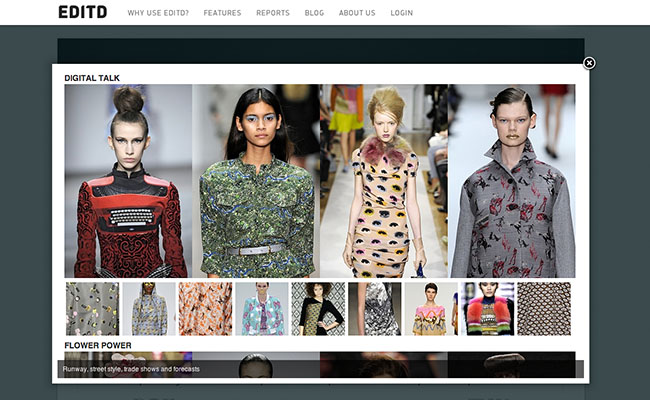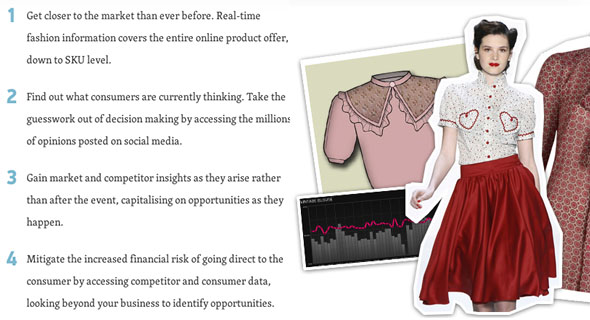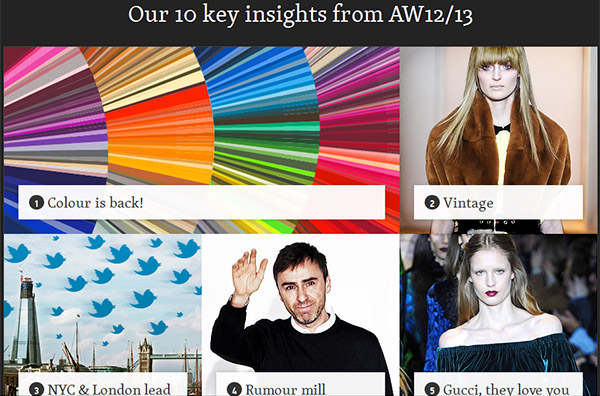
When it comes to putting together a solid collection that is well received by the media and by the consumer, it’s important to know how to “design right, sell right, and merchandise right,” which is why using forecasting companies like EDITD can be beneficial.

Co-founders Julia Fowler and Geoff Watts launched EDITD in 2009 with the means to change the way the fashion industry was making their conclusions. Both Julia and Geoff knew that if this industry would use actual data before making decisions, the amount of mistakes with quickly diminish.
As a former fashion designer, Julia was confident that her collaboration of factual data and the Internet would soon grow to be the new and next best thing to traditional forecasting. So with the help of Geoff’s data knowledge and passion for technology, they were able to create tools that would help make EDITD a must-have resource for apparel, fashion and luxury people all around the globe.
EDITD’s team of experts provides resources that help fashion businesses and labels learn to correctly price products, recognize what sells, listen to consumers and ultimately make decisions that will better their fashion future. This trend forecasting company also makes sure that there will be no more guessing about what people want because they provide, “a comprehensive suite of real-time data services covering the entire product lifecycle with an unrivaled range of applications – helping you make products your customers will love.”
However, there is something else that sets this forecasting company apart from the many. They promise to give brands, retailers and suppliers real evidence rather than opinion based evaluations. EDITD clients can know that the coverage their getting is of the real-time market as well as real-life consumer opinions and not a fashion robot, making predictions of what is to come in the world of fashion.

I had the pleasure of speaking with Katie Smith, a member of the EDITD team and she shared more about the company and what they have to offer.
StUF: Tell us about EDITD and what it does.
EDITD (KS): EDITD provides data for the fashion industry: which in turn helps fashion professionals make better business decisions around what to stock or produce. There are lot of mistakes made in the fashion industry, which leads to discounting and wastage – we exist to readdress that.
StUF: Can you explain exactly what trend forecasting entails?
EDITD (KS): Traditionally trend forecasting is about identifying newness that will translate into commercial success. Within the fashion industry, that may entail scouring the streets for influential dressers, visiting cool destinations and close observation of the art and music worlds. This model of trend forecasting relies on the instincts of a few professionals who have the ability to spot patterns in behavior and are adept at research: it can take a whole career working in the industry to have the ability to foresee what’s next!
StUF: What makes EDITD special as a trend forecasting site?
EDITD (KS): At EDITD, we detect and uncover those trends differently. The traditional method of having a small in-house team deciding amongst themselves what direction the industry will take is a risky business. What qualifies those people to understand the needs of an entire market? So, we quantitatively monitor and give scale to real events: what consumers are talking about online and what is actually selling. That way, our trend analysis is backed by data and involves far less risk taking.
StUF: What can designers/retailers expect when using your services?
EDITD (KS): EDITD’s service gives designers and retailers confidence in the direction they take their business. For a designer that may mean understanding the commerciality and timing of a particular colour shade. For a buyer it could be an insight into how well a competitor’s latest range of knitwear is retailing – right down to which sizes are selling out, how and when the price has changed and if they restock. And for a digital marketer it could be tracing how successful newsletter campaigns at the brands on their radar are. This is presented in an easily read interface, allowing clients to filter through to the exact information they need.
StUF: Why is trend forecasting important and how can it help build a successful fashion business?
EDITD (KS): Trend forecasting is hugely important to ensure the commercial success of future seasons. Whilst a brand or retailer may want to have unusual and quirky pieces within their range, they need to balance these out with safe sells. Trends become of critical importance when they aren’t solely predictions: that’s why the industry demands a fact-based approach. Rather than being spoon-fed the garment shapes forecasters think work next season and leave it there, the new methods of trend analysis look at global pricing structures, consumer sentiment towards even the most minute of components and street style from the most influential sources from every corner of the planet.
StUF: What is a good way for designers who are just starting out to get a handle on trend forecasting as a means of growing their business?
EDITD (KS): The main goal of any new designer (or established for that matter) is to get your product out there and targeted to your customer; whether that’s selling directly to individuals from your own website or being stocked by a retailer, it’s the buyer you target. Going into retail isn’t that different to going into war – you need to be armed with the right tools. It’s essential to have a good understanding of the specifics of how and what a retailer stocks: being clued up about their styles, price points and discounting patterns means you go into conversations prepared. Listen to and engage with your individual customers and use some sort of scale to measure and assess their expectations.
Fashion is a commercial business, get these fundamentals wrong and you can’t grow your business.
StUF: How do you feel that technology has changed the industry of trend forecasting? Has it been beneficial?
EDITD (KS): Technology has certainly been the enabler for our approach to trend data. A few years ago we picked up on what effect the growth in social networking was going to have on fashion: the volume of online conversation there would be about fashion, the real-time nature of consumer’s demands and the decline in traditional print media’s 3 month delay in delivering trends. This change not only generated a rich pool of fantastic data for us to start analyzing, but as confidence in online retail grew, the data we were uncovering from online sales became a really accurate reflection of the fashion industry as a whole. Now we’re in a really strong position where technology enables us to make firm, assured conclusions about the industry.
Technological advances in manufacturing and distribution has had a big impact of fashion forecasting too. The industry now has the ability through fast production cycles to capitalize on trends speedily, as well as the flexibility to reorder and replenish best sellers which sees successful trends sticking around and evolving across seasons.
StUF: Any great resources you can recommend to upcoming designers on a budget? (tradeshows, events, websites, books)
EDITD (KS): Well, a good place to start would be our blog! In it we explore some of the keys trends and release insights into commercial and social data. We also look at bigger picture stuff, like the changes in the way consumers shop, the most successful marketing tactics and profile emerging markets.
Around collection show time we also put out data dense reports, which are free to access for all. They reveal what people online think about each fashion week’s designers, new trends and prints. We cram them with colour data and charts showing what got people talking. AW12/13 reports can be found on our website, as well as commercial reports we put out throughout the year.
There are also a lot of consumer sites, which generate data that even on a small scale you can analyze. Think about Pinterest – search for the type of print you’re considering running, or the garment shape you’re working on, then compare the number of images and repins. It’s all a measure of consumer interests and is an achievable way of in-house trend tracking.
Stay on top of sites like Polyvore and Lookbook.nu – keep an eye on what recurring garments or themes are featuring in user’s moodboards or are being worn by the streetstyle bloggers posting images of themselves. There’s also relatively new sites around like Go Try It On, where users post snaps of their outfit ideas or from changing rooms and other people on the site will comment, give tips and share their opinions. These are all fashion-hungry consumers and have ability to detect trends far quicker than you with your busy schedule might! The key here is to stay aware of what’s going on in the world without making assumptions, if you do this, then you’re on the right track.
